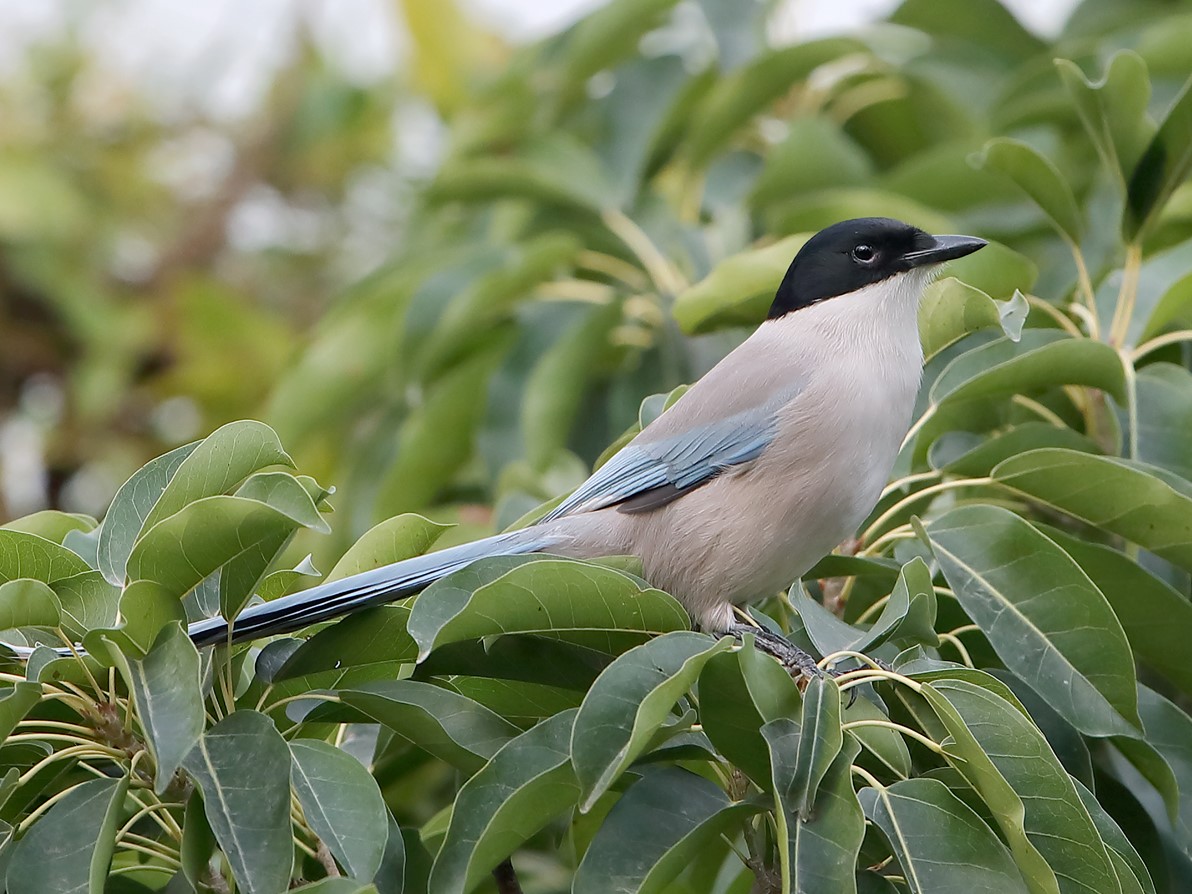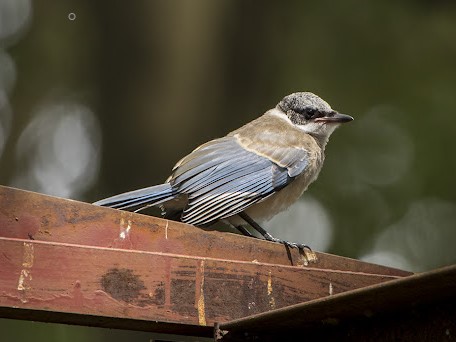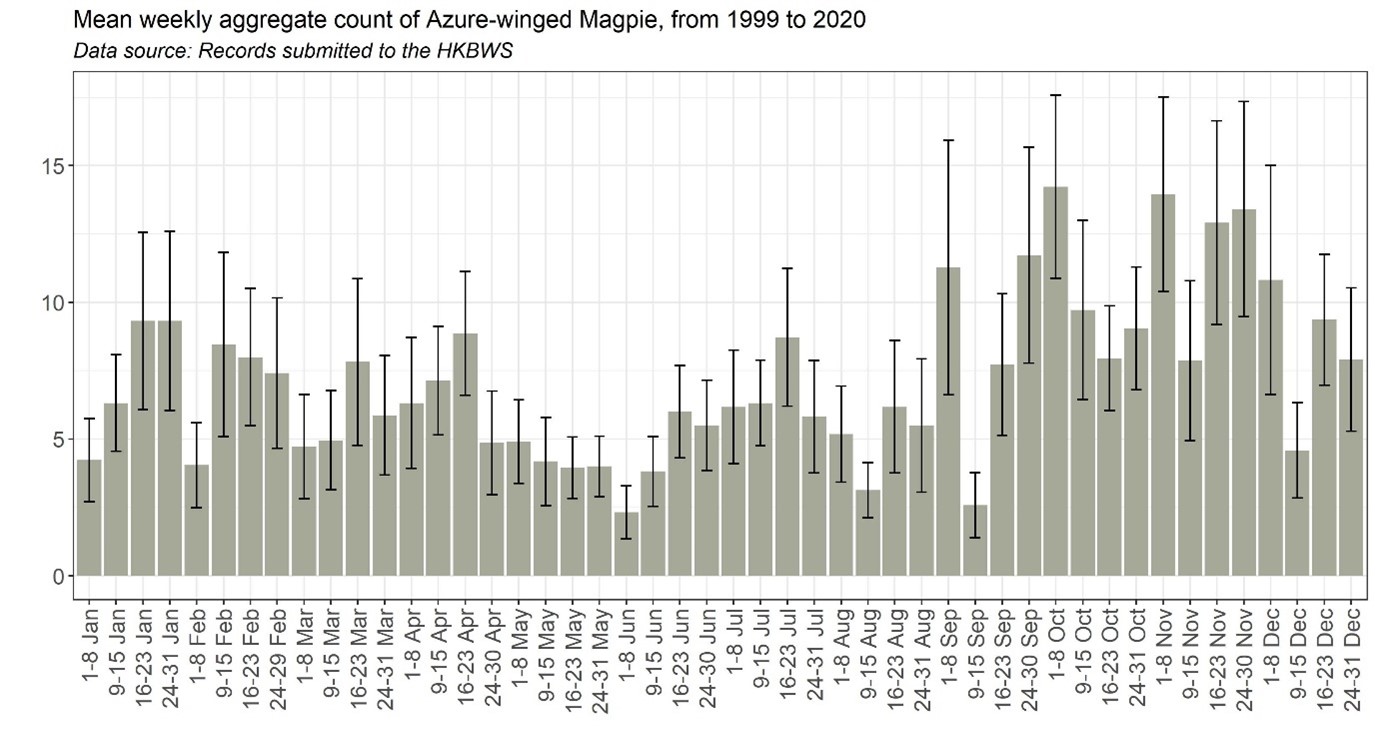Azure-Winged Magpie 灰喜鵲 Cyanopica cyanus
Category IIB. Locally common breeding resident in the Deep Bay area centred around Mai Po.
IDENTIFICATION

Dec. 2019, Michelle and Peter Wong.
33–38 cm. Distinctive, with black hood, greyish-mauve mantle and powder blue wings and tail, the latter long and graduated. Tail tipped white. Sexes similar.

Jun. 2016, Matthew Kwan.
Juvenile is browner overall with pale fringes to the crown feathers and white-tipped greater coverts.
VOCALISATIONS
Loud, distinctive and varied set of vocalisations, some of which can be heard in the following recordings.
DISTRIBUTION & HABITAT PREFERENCE
In its native range it favours lowland thickets with large mature trees, parks and overgrown gardens. The current breeding population mainly occurs in the Deep Bay hinterland, where they are mostly found in village edge, orchards, mixed woodland with large trees and fruit trees on fish pond bunds.
Although the former population on HK Island became extinct in the mid-1990s, the breeding population in the Deep Bay area, which established in 1998, experienced rapid population growth in the subsequent decades. The breeding range increased from 0.08% to 1.01% of 1km squares as measured by the breeding bird surveys of 1993-96 and 2016-19, while the wintering range increased from 0.17% to 0.91% between the winter atlas surveys of 2001-05 and 2016-19. As an extremely sedentary species, the population expanded but remained largely in the Deep Bay area extending to Kam Tin.
In addition, this century birds have been recorded at other locations such Bride’s Pool, Clearwater Bay, Ho Chung, Kowloon City, Kowloon Hills, Lin Ma Hang, Luk Keng, Ping Che, Ta Kwu Ling, San Po Kong, Lam Tsuen, Stonecutter’s, Tung Chung, Tung Ping Chau and Wong Tai Sin. It is likely that some of these are ex-captive individuals, while the remainder are considered to derive from such.
OCCURRENCE
Four presumably released or escaped birds were first noted at the Zoological and Botanical Gardens in 1975 (Chalmers 1986). The population expanded to peak at about 20 birds in 1985. However, it declined in the following years until only one bird apparently remained in 1994. Azure-winged Magpie was occasionally recorded in urban parks such as Kowloon Park, Morse Park and Kowloon City Park but did not establish a breeding population.
The highest count since the establishment of the Deep Bay breeding populations is 88 on 3 September 2013 at Mai Po. Long Valley and Ho Sheung Heung also appear to support small populations but whether they are self-sustaining remains questionable. However, although most records in Long Valley consist of no more than ten individuals, a high count of 40 was recorded on 11 February 2019.
The Deep Bay population is stable throughout the year. Large aggregations usually occur in autumn, probably associated with post-breeding activities where juveniles are present.
As a common pet bird, released or escaped birds are sighted from time to time. Ex-captive birds can also occur in other localities though often in poor condition, e.g., three birds on 1 October 2003 at Bride’s Pool and one on 10 July 2005 at Sha Tin Pass.
BREEDING
Breeds in small loose colonies, with the number of nests less than the number of birds in the group suggesting cooperative breeding. The breeding season extends from April to July. Fledglings have been seen from May to July. Breeding activities occur mainly in or near Mai Po, including in 2020 Palm Springs residential estate.
BEHAVIOUR, FORAGING & DIET
Azure-winged Magpies most often occur in groups of up to 20 birds. They tend to be arboreal, often perching on overhead wires and posts, but will readily come to the ground to feed.
RANGE & SYSTEMATICS
Of the two subspecies, C. c. cyanus, which breeds in northern Mongolia west to Ussuriland and south through northeast China to Jiangsu and the Korean peninsula (Madge 2020), is presumed to be that which occurs in HK. The second taxon, C. c. japonica, occurs in Japan.
CONSERVATION STATUS
IUCN: Least Concern. Population trend unknown.
Figure 1.

Chalmers, M. L. (1986). Annotated Checklist of the Birds of Hong Kong. Hong Kong Bird Watching Society, Hong Kong.
Madge, S. (2020). Azure-winged Magpie (Cyanopica cyanus), version 1.0. In Birds of the World (J. del Hoyo, A. Elliott, J. Sargatal, D. A. Christie, and E. de Juana, Editors). Cornell Lab of Ornithology, Ithaca, NY, USA. https://doi.org/10.2173/bow.azwmag2.01

